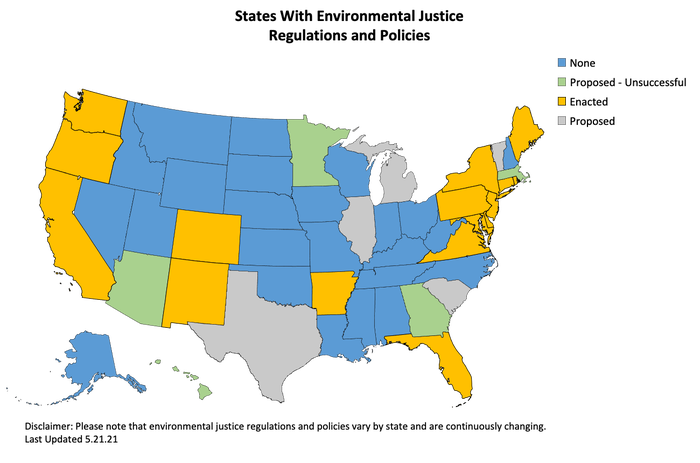State Trends in Environmental Justice Legislation

As most state legislative sessions begin to wind down, the National Waste & Recycling Association (NWRA) has continued to stay engaged with state legislatures across the country. There have been numerous topics of significance to the industry, with the most recent trending legislation addressing environmental justice (EJ).
There are many definitions of environmental justice; however, the U.S. Environmental Protection Agency’s (EPA) definition is the most used by state legislatures:
The EPA defines environmental justice “as the fair treatment and meaningful involvement of all people regardless of race, color, national origin, or income, with respect to the development, implementation, and enforcement of environmental laws, regulations, and policies.”
A good example of the environmental justice issue being brought to the nation’s attention was the protest in the early 1980s against a polychlorinated biphenyl (PCB) landfill in Warren County, N.C. The protest was unsuccessful in halting construction; however, the main reason for the protest was identified as an example of environmental justice in practice in communities of color and lower income. This event drew national attention and is viewed as the pivotal event sparking the environmental justice movement.
Moving into the 1990s, President Bill Clinton in 1994 was a powerful champion of this important matter when he addressed and issued Executive Order No. 12898, calling for federal agencies to incorporate environmental justice into their work. President Clinton instructed federal agencies to pursue environmental justice policies that would limit the “disproportionately high and adverse” effects of environmental harms on low-income communities and people of color.
Thirty years later, the current administration led by President Biden aims to build upon the work President Clinton started in the 1990s. Biden’s Environmental Justice Plan focuses on the creation of two new federal councils: a White House Environmental Justice Interagency Council and an Office of Climate Change and Health Equity at the Health and Human Services Department. On January 27, Biden signed Executive Order No. 14008, creating these councils, calling for increased environmental justice-specific enforcement and aiming to improve community access to environmental data.
One of the EPA’s responses to the Biden-Harris administration’s directive to all federal agencies was announced in an EPA press release on April 7, where the EPA administrator announced agency actions to advance environmental justice. The EPA outlines environmental justice by region and provides helpful resources on its environmental justice homepage.
In order to better meet the agency’s responsibilities related to the protection of public health and the environment, the EPA began developing a new environmental justice mapping and screening tool in 2010 called EJSCREEN. The EPA began to use an early version of this tool in 2012, and it was peer reviewed and released to the public in 2015.
Due to the level of focus by the EPA and Biden administration on environmental justice, a growing number of states are proposing and enacting regulations and polices related to environmental justice. The most recent environmental justice policy to pass is Senate Bill 5141 sponsored by Sen. Rebecca Saldana (D-37) in Washington state. This bill created the Healthy Environment for All (Heal) Act and requires several state agencies to take into account disproportionately impacted communities to ensure officials are working to reduce environmental harms in those places.
In North Carolina, House Bill 784 sponsored by Rep. Pricey Harrison (D-57) was introduced on May 2. This bill would direct the North Carolina Department of Environmental Quality (DEQ) to deny a permit application for a solid waste management facility, such as a landfill, on environmental justice grounds. That is, if the cumulative impact of the facility would have a disproportionately adverse impact on low-income or minority community. Before the DEQ or any commission with permitting authority can consider an application for a permit or approval for a new or expanded facility or project, they would have to hold at least one public hearing in the overburdened community, provide 60 days’ notice and include a hearing officer’s report in response to community input.
One state leading the charge in environmental justice is New Jersey. In April 2018, Gov. Philip D. Murphy signed Executive Order No. 23, which directed the New Jersey Department of Environmental Protection (NJDEP), in consultation with the Department of Law and Public Safety, to develop guidance for all executive branch departments and agencies on environmental justice considerations in policymaking. Following that, on September 18, 2020, Gov. Murphy signed into law Senate Bill 232 sponsored by Sen. Troy Singleton (D-7), which would require the NJDEP to evaluate the environmental and public health impacts of certain facilities on overburdened communities when reviewing applications for a number of facilities including transfer stations, recycling facilities that process more than 100 tons per day, landfills, waste-to-energy facilities and medical waste incinerators.
To further illustrate the actions taken by each state, the following map provides an overview of proposed and enacted environmental justice regulations and policies. Some states have clearly defined environmental justice plans and policies while others remain vague.

As an example, Florida is listed as “Enacted” as it developed an Environmental Justice Equity Commission from a law that passed in 1998, but there are no current legislation proposed. States like Hawaii are listed as “Proposed/ Unsuccessful” as no legislation has passed, but the state has had a draft environmental justice plan in place since 2015. It is unclear if the state of Hawaii Department of Health and Environmental Health Administration implemented this plan. Maine is listed as “Enacted” as the Maine Department of Environmental Protection has rules to include environmental justice in February 2021. NWRA staff are continuing to follow the environmental justice movement and gather research on a state-by-state basis.
About the Author(s)
You May Also Like


